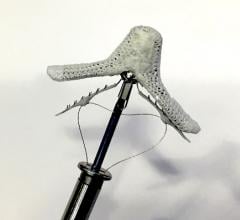A new technology for detecting low glucose levels via electrocardiogram (ECG) using a non-invasive wearable sensor, which with the latest artificial intelligence (AI) can detect hypoglycemic events from raw ECG signals has been made by researchers from the University of Warwick.
January 13, 2020 — Stryker announced it is launching a voluntary field action on specific units of the LifePAK 15 ...
January 13, 2020 — The U.S. Food and Drug Administration (FDA) has approved clinical trial that will compare the ...
Providing exceptional cardiovascular care for patients to achieve the best possible outcomes is the number one goal for ...
The Consumer Electronic Show (CES) is the world's gathering place for consumer technologies, with more than 175,000 attendees and more than 4,400 exhibiting companies. New healthcare technologies are among the top trends at CES. This video offers a quick look at the trends specific to healthcare technology.
Haval Chweich, M.D., medical director of the cardiac critical care unit (CCU) at Tufts Medical Center, and assistant professor at Tufts University School of Medicine, explains the role of intensivists on the cardiac care team.
Richard Botto, CVT, RCSA, chief cardiovascular technologist, division of cardiology, cardiac cath lab, and Melissa Smith ...
Cardiac positron emission tomography (PET) is growing in popularity among cardiologists because it provides the ability ...
January 9, 2020 — Maulik Majmudar, M.D., chief medical officer at Amazon will be the keynote speaker at the upcoming ...
January 9, 2020 – Researchers may have discovered a way to turn back the clock on aging heart muscles in fruit flies, a ...
January 7, 2020 — Abbott announced U.S. Food and Drug Administration (FDA) approval of a new alternative surgical ...
When performing radiofrequency (RF) ablation to treat cardiac arrhythmia, medical professionals must balance the safety ...
The American Society of Echocardiography (ASE) has updated its guidelines for using echocardiography to image ischemia. Ischemic heart disease (IHD) occurs when the arteries of the heart cannot deliver enough oxygen-rich blood to the heart and is the leading cause of death in the United States. Stress echocardiography is routinely used for the detection of flow-limiting blockages in the coronary arteries in patients with symptoms such as exertional chest pain or shortness of breath. In this era of multimodality imaging, understanding the role and advantages of stress echocardiography for the patient presenting with symptoms of potential cardiac origin is essential.
January 7, 2020 — The U.S. Food and Drug Administration (FDA) has accepted a supplemental new drug application (sNDA) ...
Karen Ordovas, M.D., MAS, professor of radiology and cardiology at the University of California San Francisco (UCFS) ...
Change Healthcare Cardiology Hemodynamics is an integrated hemodynamic monitoring system for monitoring vital signs and ...

Here is the top cardiology content on the Diagnostic and Interventional Cardiology (DAIC) website from 2019 based on the analytics of its record 3.1 million pageviews.
January 2, 2020 — In early December 2019, leaders of the European Association for Cardiothoracic Surgery (EACTS) ...

Here are the top performing 25 videos posted to the DAIC website in the past year, based on Google Analytics. These the ...


 January 13, 2020
January 13, 2020















